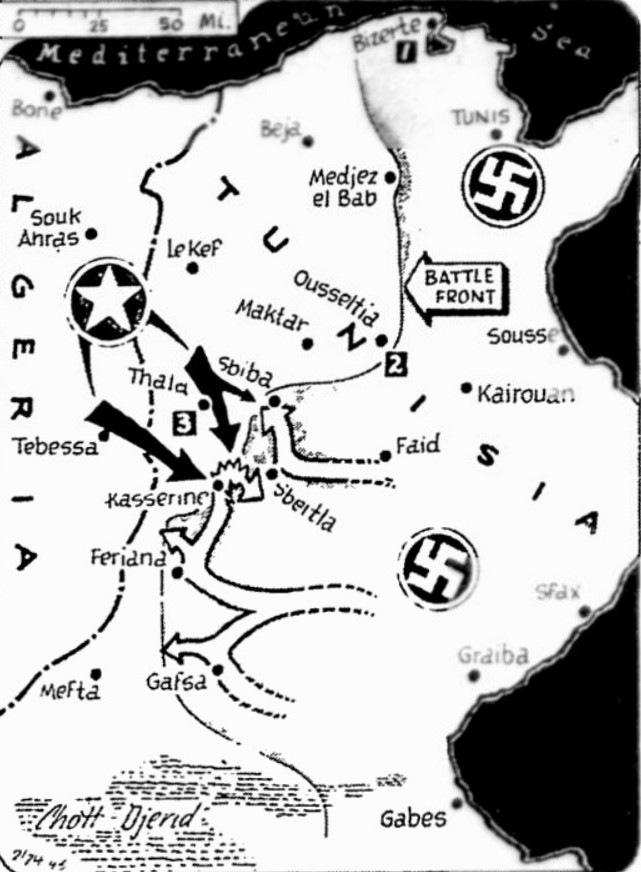The Pittsburgh Press (February 24, 1943)
Furious attack by Allied forces Rommel retreat
Planes rip Germans in 24-mile withdrawal into Kasserine Pass
By Virgil Pinkley, United Press staff writer
Rommel falls back on Kasserine in central Tunisia under heavy land and air pressure after advancing to within four miles of Thala. Developments on the front today:
1. Heavy bombing raid on Bizerte by U.S. planes revealed.
2. German thrust at Allied positions west of Ousseltia repulsed.
3. Rommel driven back 21 miles from Thala almost to Kasserine.
Allied HQ, North Africa –
Marshal Erwin Rommel’s armored units are being driven in retreat today back to the Kasserine Pass, harassed by Allied planes and by U.S. and British troops which stopped the enemy dead in his tracks in a three-day battle.
The crack German 21st Armored Division, which rolled out of the Kasserine gap three days ago and fought its way into a right pocket before the gap and was apparently falling back into the vital pass itself.
Thala is 28 miles northwest of Kasserine. Since the Germans penetrated to within four miles of Thala and were then driven back to Kasserine Pass, their retreat was approximately 24 miles.
The Germans, overreaching themselves in the dash for Thala, found their position there untenable and began to retire early yesterday. As they fell back, the Allied air force – apparently dominant in the skies over the battle area – gave the retreating Germans the worst pasting they have yet experienced in Tunisia.
It was similar in intensity and volume to the air attack launched by the Allies at El Alamein when Gen. Sir Bernard L. Montgomery’s British 8th Army started the offensive that has now carried it to the Mareth Line.
Thus the tide of battle in Tunisia swung sharply in favor of the Allies with the German push exhausted and with the 8th Army, about 100 miles away from other Allied forces in Tunisia, threatening Rommel’s flank from the south.
Large numbers of prisoners were taken by the Americans and the British. On the plain in front of Djebel el Hamra alone, the Americans captured 300 Italians and enough small arms and other weapons to equip a battalion.
The Germans made a desperate attempt to disengage their armor and infantry from the British in the Thala area. But the British tracked them every step of the way in the retreat while U.S. artillery blasted away at the German columns that were winding back along roads over which they advanced three days ago.
Then the Americans, timing their action with the British, struck out from the Djebel el Hamra area and forced the Axis troops back to within three miles of the Kasserine gap. The full extent of the German losses are still unknown, but it can be definitely said they are considerable.
One factor in the German defeat was that the bad weather broke after 10 days, allowing the Allied air force to get into action on a big scale.
The retreating Germans caught a fury of cannon fire, machine-gun bullets and bombs from Flying Fortresses, Mitchells, Marauders, Bostons and British and U.S. fighters.
The Kasserine Pass was a roaring hell of exploding bombs. Marauder Bombers, escorted by Lockheed Lightnings, swung back and forth over the pass, scoring direct hits on gun emplacements.
Flying Fortresses ranged over to the eastern side of the pass and bombed a road choked with Axis vehicles. The Fortresses also struck at the town of Kasserine itself and inflicted severe damage on a column of German motor transport which got itself bottlenecked in a narrow street.
As the British and U.S. forces converged on the Kasserine Pass, some German forces tried to escape down the Fériana Road. Allied planes went after them, sweeping back and forth in low-level machine-gunning attacks as the Germans tumbled out of trucks and sought refuge in ditches along the road.
The Allied aerial offensive extended all the way northward to Bizerte, where bombers attacked on the night of Feb. 22-23. Yesterday, an Axis airfield at Kairouan was bombed.
Allied bombers made a sweep off the Tunisian coast and sank five power barges carrying motor transport, fighter escorts destroyed one Axis plane.
Eight Allied planes are missing from all operations, but one pilot is safe. Two Allied aircraft, previously reported missing, are safe.
An Allied communiqué said:
Following heavy fighting which has continued for the past three days in the area north and northwest of Kasserine, U.S. and British forces, after successfully holding the enemy’s attack, forced a withdrawal in this sector.
Our infantry and armored units were in contact with the enemy throughout the day, inflicting heavy casualties, taking many prisoners and securing some abandoned enemy material.
Continuous attacks throughout the day were made by our fighters and bombers on the withdrawing enemy column. A number of motor vehicles were destroyed in the battle area.
In the Essadour area west of Ousseltia, an enemy attack was successfully repulsed.
In the northern sector, our offensive patrol activity continues.
Our fighter also maintained offensive patrols over the forward areas. Three enemy fighters were shot down.
On the night of February 22-23, our bombers raided Bizerte. Yesterday, among other targets, the enemy airfield at Kairouan was bombed.
In a sea sweep off the Tunisian coast, bombers sank five power barges carrying motor transports. The fighter escort destroyed one enemy aircraft.
From all these operations, eight of our aircraft are missing, but one pilot is safe. Two of our aircraft previously reported missing are safe.
It had not yet become apparent whether Allied forces were strong enough to drive the Germans back to Kasserine Pass, or out of it.
Battle tests line
Actually, the battle for Thala was fought with comparatively small forces, and all actions will probably be so tough, until the main battle of Tunisia begins.
Neither side was in position to risk big masses of men and weapons at this stage, unless a big reward was probable.
But the battle around Kasserine is important in that the result will determine whether the new Allied defense line can be held, while the High Command methodically completes preparations for the climatic drive.
Reports of the 8th Army’s progress in southeastern Tunisia were still scanty. One report said its guns were shelling German positions around Mareth, northern bastion of the Mareth Line. The Germans said last night that the 8th Army was marking time, while it brought up all its artillery to pulverize Mareth Line fortifications.
The German official news agency said “absolute quiet” obtained over the central Tunisian front yesterday.
BBC quoted a British correspondent, “on authority of the Allied staff,” that the Germans threw 220 tanks, practically all Axis armor in Africa, into the recent offensive.
He said the offensive was a big gamble, and partly succeeded as such, German forces farther north, he said, had now begun as series of minor pushes to test British lines, and make the British think twice before sending reinforcements south.

